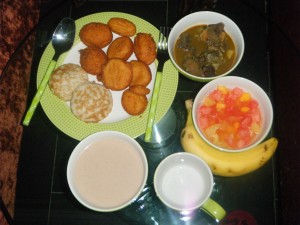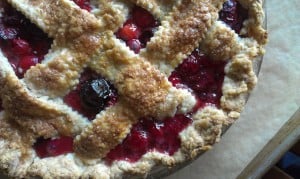I am usually not good at taking pictures of food because I tend to have eaten halfway through before remembering to take a photo. Therefore, this is a rare photo of a typical iftar at home, that is, at my mother’s.
Starting from the cup of water, which is at the bottom right, and moving anti-clockwise:

– A banana
– Some fruit salad
– Pepper soup
– A plate of bean cakes (akara) and rice cakes (masa)
– Kunun gyada (a type of gruel made from groundnuts)
This is also the procession in which they are eaten.
Once it is time to break our fast, or “shi inu” which in Yoruba literally means “to open one’s mouth”, we start with a cup of water then move on to the fruit. For my family, a typical fruit salad has watermelons, pineapples, oranges, and pawpaw (papaya).
Upon eating the fruits, there is a break for prayer.
When we return, it is time for the pepper soup. The one in the photo above, I recall, had offal, intestines and tripe. I am not a big fan of offal, but I really enjoy cow leg and skin in pepper soup. As the name suggests, pepper soup is fiery and spicy.
Next to pepper soup are two kinds of cake: the brown is akara and is made from blending beans (black eyed peas or Nigerian brown beans), with red pepper and chillies. I am in charge of making akara for iftar because I have managed to convince everyone that I make it best. Akara is made by mixing the blended beans and then frying it. I add an egg to the mixture in order make the akara fluffy; that is my secret to excellent akara. Next to the bean cakes are rice cakes, otherwise known as masa. Masa is usually sweet and just slightly oily. I love it best when it is burnt and crispy around the edges. We do not make masa at home but by it in bulk and freeze it so that it lasts for the whole month of Ramadan.
The final dish is kunun gyada, I had some trouble translating this to English, but I am pretty certain it is a gruel. Kunun gyada is made with a type of spiced groundnut paste. When we make kunun gyada we thicken the groundnut paste with another paste for what we call “pap” (pap is essentially another kind of gruel). My mother grinds grains such as millet and guinea-corn to make the paste for pap. Both the nut and cereal pastes are boiled in water before the final, and best in my opinion, ingredient is added. This ingredient is tamarind; kunun gyada just does not taste the same without it. Sugar is also added to kunun gyada, which when prepared is a wonderful blend of groundnut and cereal, and tastes sweet and sour.
The kunun gyada goes great with the akara, while the masa goes great with the pepper soup. By the time all this food is eaten, it is already time to pray isha.
Edited to Add: For more on Ramadan, and to read the rest of the posts in MMW’s Ramadan 2012 series, click here.












